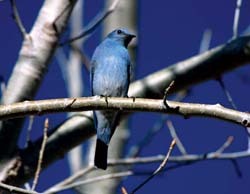(Mountain Bluebird, WBU Inc.)
Nature Happenings
- Project FeederWatch ends this month, feederwatch.org
- Bald Eagles begin their nesting behaviours.
- Ravens, crows and Canada Geese begin nesting.
- Ground Squirrels are beginning to emerge from hibernation.
- Listen for singing Northern Leopard Frogs, Boreal Chorus Frogs, and Columbia Spotted Frogs.
- Phoebes return this month.
- Song Sparrows begin calling.
- South winds bring major waves of migrating birds like thrushes and warblers.
- Flickers establish their territories late in the month.
- Dark-eyed Junco population increases this month.
- Robins returning now.
- Mourning Cloak Butterflies emerge on the first sunny days.
- Wildlife Week, the week of April 4-9 - a program of the Canadian Wildlife Federation to celebrate our country's natural heritage and play an important role in its conservation.
- Pairs of Canada Geese stake out potential nest sites often standing on frozen ponds waiting for the ice to melt.
- Northern Saw-whet Owls give their piping territorial calls along the North Saskatchewan River valley.
- Richardson's ground squirrels are now out in prairies and pastures.
- Osprey are sitting on their eggs.
- Red-tailed Hawks return to set up nesting territories.
- The yap and yodel of coyotes is heard across the province, including the river valleys in Edmonton and area.
- Prairie crocus or pasque flower is a traditional harbinger of spring.
- Our largest fish, the lake sturgeon, may live for 60+ years.
- Mountain Bluebirds are nesting by end of month. Be sure to have their houses ready. A Mountain Bluebird was spotted east of Edmonton on March 11, 2016. A male Mountain Bluebird was spotted in West Edmonton Apr 1, 2018.
- Tree Swallows return and compete for tree holes and nest boxes throughout the region.
- Long-toed salamanders are moving to their breeding ponds.
- Snakes are beginning to move out of their hibernacula in southern Alberta.
- Gulls are migrating into the region.
- By early April, grizzly bears begin to emerge from their dens.
- By mid-April, American kestrels arrive in south-central Alberta and are often found nesting in holes and cavities in trees, banks, and nest boxes.
- Listen for the dancing of Sharp-tailed Grouse.
- Lyrids meteor shower will peak between April 22 and 23.
- The April 5 full moon is called the Pink Moon.
- Earth Day, Saturday, April 22. Earth Day is the largest environmental event in the world. More than six million Canadians— typically including nearly every school-aged child—participate in an Earth Day activity in their communities.
- Sources
1. Wild Birds Unlimited
2. Alberta's Watchable Wildlife
3. Royal Astronomical Society of Canada


